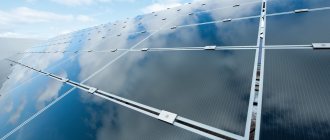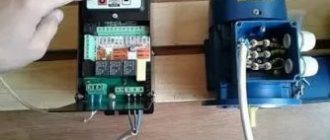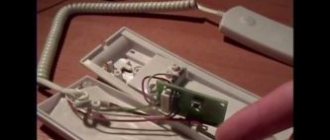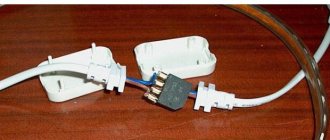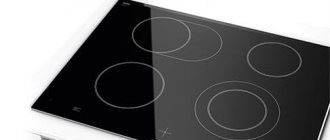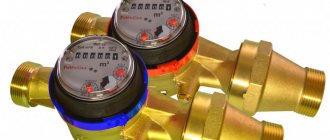Modern power plants that generate electric current from solar radiation are becoming increasingly profitable and popular. For the operation of such stations, the interaction of several complex devices is used, one of which is a current converter. The inverter of a solar power plant receives direct current at the input and produces alternating current at the output, on which most modern equipment operates. In this article we will talk about the types of such converters, the rules for their connection and selection criteria.
Definition of solar cell
Structurally, a solar battery is a circuit that converts one type of energy into another. In particular, light energy is converted into electrical energy. Moreover, the result of the transformation is an electric current of constant magnitude.
The active elements of the solar panel design are semiconductors that have the properties of photochemical synthesis. For example, silicon (Si), the use of which marked the very first research in the field of generating solar electricity.
The simplest set of a solar panel and a car battery already makes up the design of a real home energy system
At the moment, silicon is no longer considered a non-alternative chemical element, based on which it makes sense to build solar panels from panels, including with your own hands.
Other representatives of the periodic table now seem more promising and effective (energy return figures in brackets):
- Gallium arsenide GaAs (crystalline 25.1).
- Indium phosphite InP (21.9).
- Indium phosphate with gallium + Gallium arsenide + Germanium GaInP + GaAs + Ge (32).
A solar panel should be viewed through the eyes of the average person as a semiconductor wafer (silicon, etc.), each side of which is a positive and negative electrode.
Under the influence of sunlight, as a result of chemical photosynthesis, electrical potentials are formed at the panel electrodes. It would seem that everything is simple. All that remains is to connect the wires to the load and use electricity. But in reality everything is somewhat different.
Efficiency of solar panels
Achieving a high degree of efficiency from using a solar battery is extremely problematic. Moreover, when the solar battery is made by hand, and attempts are made to obtain energy for the domestic needs of an entire house or the economic needs of a summer cottage.
Such an industrial household installation generates 150 watts of power at a network voltage of 12 volts. True, the declared power is guaranteed with a completely open solar sky
To obtain maximum efficiency from a solar power generator, the load impedance must be continually determined and accurately matched.
There is no way to do this without the use of technologically advanced electronic devices - control controllers. But making such a controller with your own hands is a difficult task.
Photocells, on the basis of which the structure of solar panels is built, are characterized by temperature instability. Application practice indicates a significant drop in the performance of photocells as a result of an increase in their surface temperature.
This creates another, no less difficult task. Its solution requires the use of sunlight, devoid of heat. Doing something similar in makeshift conditions seems like a futile idea.
And more disadvantages of alternative energy:
- the need for significant areas for placement of battery panels;
- inactivity of the installation in the dark;
- the presence of toxic substances in the battery components (lead, gallium, arsenic, etc.);
- significant operating costs.
However, the professional production of solar power generators is steadily increasing. There are already at least five companies ready to offer modern structures for installation, including those intended for residential real estate:
- Canadian Solar
- Jinko Solar
- Hanwha Qcells
- JA Solar
- Trina Solar
DIY solar energy at home
A solar battery, assembled independently from silicon wafers, laid out in direct sunlight, is ready to be tested for the presence of voltage
Independent production of a battery based on solar panels, suitable for the needs of private households, seems to be a realistic endeavor only within the framework of modest projects.
For example, making a solar battery with your own hands to recharge a small battery, the energy of which is used to power two or three low-power (6 - 12 volt) flashlights.
For such projects, installations are made that produce a voltage of no higher than 20 volts at a current of no more than 1 A. Let's consider one of the possible options for creating a solar battery with similar performance characteristics.
To implement the project you will need:
- Wafers of silicon photocells.
- Electric soldering iron.
- Soldering tin.
- Ethanol.
- Pine rosin for soldering.
- Electrician's tool.
- Auxiliary electronic components and modules.
Prepared parts for assembling a home (country) solar panel. Each of the elements is an individual source of energy. They need to be united
The easiest way to purchase photocell (silicon) wafers is ready-made, for example, on Aliexpress. There, quite suitable designs of different sizes are sold at an affordable price.
An electrician who is familiar with electronics usually has a tool by default. Auxiliary equipment will require a battery charge regulator and an inverter.
Assembling a solar battery: step-by-step instructions
The step-by-step assembly of a solar panel generator looks something like this:
- Soldering individual plates with photocells into a single solar battery.
- Checking the operation of the assembled battery with a measuring device.
- Laying panels inside the protective structure.
- Connecting the assembled battery through the charge controller to the battery.
- Converting battery energy into the required voltage.
Soldering individual panels into a single battery is a painstaking job that requires soldering skills and attention. The complexity of the actions for the assembler is due to the fragile design of the silicon wafers.
Soldering on the plates is carried out carefully with a soldering iron of suitable power, having previously sharpened the tip at an angle of 45 degrees, using high-quality solder
It is recommended to connect the plates to one another using flat ribbon conductors. The goal is to minimize the conductor resistance as much as possible.
Soldering areas should be pre-treated with ethyl alcohol. It is recommended to solder with minimal use of rosin and tin.
Having completed the soldering, you need to check the structure for functionality. This procedure is done in the usual way, using a measuring device - a tester (pointer, electronic).
Checking the performance of a do-it-yourself solar battery using a conventional digital instrument for measuring voltage, current, resistance
On the output conductors, the output voltage and current are measured under conditions of maximum and minimum illumination of the canvas. With high-quality soldering of all plates and without the presence of defects, the result is usually positive.
Battery charge controller
A solar power installation will become more reliable and safer if a battery charge (discharge) controller is included in its circuitry. This device can be purchased ready-made.
But if you have a knack for electronics and a desire for perfection, it’s not difficult to make a charge controller yourself. For reference, you can clarify: two types of such devices have been developed:
- PWM (Pulse Width Modulation).
- MPPT (Maximum Power Point Tracking).
If translated into Russian, the first type of device operates on the principles of pulse width modulation. The second type of device is designed to calculate the so-called maximum power point.
In any case, both circuits are assembled on a classic element base, with the only difference being that the second devices have more complex circuit designs. Charge controllers are included in the system as follows:
Classic block diagram of switching on a charge controller: 1 - solar panel; 2 — battery charge/discharge controller; 3 - battery; 4 - voltage inverter 12/220V; 5 - load lamp
The main task of the battery charge controller of a solar power installation is to monitor the voltage level at the battery terminals. Preventing voltage from going beyond the boundaries when the operating conditions of the battery are violated.
Thanks to the presence of the controller, the battery life remains stable. Of course, in addition to this, the device monitors temperature and other parameters, ensuring the safety of the battery and the entire system.
To assemble an MPPT controller with your own hands, you can take a lot of circuit solutions. There are no problems in finding circuitry, you just need to make a corresponding request in the search engine.
For example, you can assemble a controller based on this, simple at first glance, block diagram:
Based on this block diagram, a fairly effective and reliable battery charge monitoring device is assembled using MPPT technology
However, for domestic purposes, a simple PWM controller is quite sufficient, since household power plants, as a rule, do not use massive solar panels. For controllers of the MPPT type, a characteristic feature is that they work with high-power panels.
At low powers they do not justify their circuit complexity. For the user, the purchase of such devices results in unnecessary expenses. Therefore, it is logical to recommend a simple PWM device for home use, assembled by yourself, for example, according to this scheme:
Schematic diagram of a simple PWM controller for a home solar installation. Works with 17 volt panel output and regular car battery
Solar battery: inverter circuit
The energy received from the sun is accumulated. At home, a standard car battery (or several batteries) is usually used to store energy.
The battery voltage and current are quite sufficient to power low-power household appliances designed for a voltage of 12 (24) volts. However, this option is not always suitable.
Therefore, in addition to the assembled structure, an inverter is connected - a device that converts the battery voltage into an alternating voltage of 127/220 volts, suitable for powering household appliances or household appliances.
Finding a suitable inverter circuit is not difficult. There are many ideas on this matter. Traditionally, the inverter circuit includes the following components:
- semiconductor solar panel,
- integrated circuit type SG3524 (charge regulator),
- battery,
- integrated circuit for controlling MOS transistors,
- power MOSFETs,
- transformer.
The block diagram of the regulator paired with an inverter looks something like this:
Block diagram of a battery voltage regulator in association with a voltage inverter-converter for a solar power plant
Solar panel protective structure
A solar battery assembled from fragile silicon wafers must be additionally protected from external influences. The protective case is made from a transparent material that is easy to clean.
Polyurethane or aluminum frame corners and transparent organic glass are just right. There is no point in explaining the intricacies of assembling the protective housing. This is a simple assembly, assembled with your own hands using a set of household tools.
An example of a home energy installation
Boost converter topology diagrams and homemade solar converter circuit diagram
Boost Converter Theory
In the boost converter topology diagram, coil L1 is charged when transistor Q1 is on. When transistor Q1 is turned off, coil L1 discharges to the battery through zener diode D1. Performing this operation several thousand times per second will result in a significant output current. This process is also called inductive discharge. For it to function, the input voltage must be lower than the output voltage. Also, if you have a solar panel, you must use an energy storage element - a capacitor (C1), which will allow the solar panel to continuously output current between cycles.
Description of the boost converter circuit diagram
The circuit consists of three main blocks, including a 555 MOS gate generator, a 555 PWM modulator, and an operational amplifier with a voltage limiter. The 555 series with cascaded output can provide a current of about 200mA and makes an excellent low power pulse generator. The 555 PWM modulator is a classic oscillator circuit based on the 555 series. To adjust the discharge time of capacitor C3 (coil charging time), a voltage of 5V is applied to pin 5.
Voltage limitation
Operational amplifier U1A calculates the battery voltage signal when the divided voltage setpoint is compared with the 5V reference voltage. When the voltage exceeds the set value, the output switches in the negative direction, thereby reducing the frequency of the generator's PWM pulses and limiting any subsequent charge. This effectively prevents overcharging.
Powering the circuit from a solar panel
To prevent unnecessary battery drain when the sun is not shining, all circuits are powered through the solar panel, with the exception of the closed-loop voltage divider, which draws about 280uA.
Logic level MOSFET
Since the circuit must operate at low voltage levels (this circuit operates from an input voltage of at least 4V), it is necessary to install a logic level MOSFET. It will open at a voltage of 4.5V. For this purpose I used a power MOSFET transistor MTP3055.
Voltage clamping using zener diode D2
In this circuit, DO NOT DISCONNECT the battery, otherwise the MOSFET transistor will burn out. Therefore, to protect it, I installed a 24V zener diode D2. Without this zener diode, I myself have burned out many MOS transistors.
MPPT function
When the solar panel voltage/current increases, the PWM generator increases the pulse frequency, which in turn causes the output current to increase. At the same time, additional voltage is applied to the coil, thus increasing its charging current. The result is that the boost converter actually "goes hard" when the voltage goes up, or "goes hard" when the voltage goes down. To maximize energy transfer in bright sunlight, potentiometer R8 is adjusted so that the battery charging current is maximum - this will be the point of maximum power. If the circuit is working correctly, there will be a very flat peak when R2 is rotated. Diode D3 performs automatic MPPT regulation more accurately by subtracting a fixed voltage from the voltage difference between the battery and the average voltage through capacitor C3. In low light conditions you will find that resistor R3 is not optimal, however it will not be completely removed from the chain. Note that smart MPPT controllers can also perform better at full range, but this improvement is extremely ineffective.
Component ratings
The circuit is configured for a voltage of 9V, the solar panel for a power of 3W. Boost converters are quite finicky and won't work over a wide range of conditions - if your system uses different power rating limits for the solar panel, then expect a problem. The only components that require adjustment are coil L1 and capacitor C3. I was surprised that the repetition rate was very low (about 2kHz). I started with a 100µH coil, but the circuit works better at 390µH - I originally wanted around 20kHz. For best performance, charge the coil 5 to 10 times the solar panel current, then allow a long period of time (3X) to allow the coil to fully discharge. This will ensure acceptable operation when the power supply voltage is close to the battery voltage. Note that low impedance coils provide the best efficiency. The greatest loss really occurs in a Schottky diode, and the least loss is what these diodes are designed for.
High frequency operation is usually preferred. This will minimize the size of the coil. However, for experimentation, use the coil that will work best.
The proposed components are indicated in the diagram. Naturally, the charger can be adapted to suit your requirements.
Oscillograms
List of radioelements
| Designation | Type | Denomination | Quantity | Note | Shop | My notepad |
| U1 | Linear regulator | LM78L05 | 1 | LM78L05ACZX | Search in Utsource | To notepad |
| U1A, U1B | Operational amplifier | LM358 | 1 | Search in Utsource | To notepad | |
| U2, U3 | Programmable timer and oscillator | NE555 | 2 | Search in Utsource | To notepad | |
| Q1 | MOSFET transistor | NTD4906N-35G | 1 | Search in Utsource | To notepad | |
| D1 | Schottky diode | 1N5817 | 1 | Search in Utsource | To notepad | |
| D2 | Zener diode | 1N5359B | 1 | Search in Utsource | To notepad | |
| D3, D4 | Rectifier diode | 1N4148 | 2 | Search in Utsource | To notepad | |
| L1 | Inductor | Boums 2100LL-391-H-RC | 1 | 390 µH, 2.4A | Search in Utsource | To notepad |
| C1 | Electrolytic capacitor | 470uF x 25V | 1 | Nichikon UHD1E471MPD6 | Search in Utsource | To notepad |
| C2, C4, C5 | Capacitor | 0.1 µF | 3 | Search in Utsource | To notepad | |
| C3 | Capacitor | 0.01 µF | 1 | Search in Utsource | To notepad | |
| R1 | Resistor | 22 kOhm | 1 | Search in Utsource | To notepad | |
| R2 | Trimmer resistor | 10 kOhm | 1 | Search in Utsource | To notepad | |
| R3, R4, R9 | Resistor | 10 kOhm | 3 | Search in Utsource | To notepad | |
| R5 | Resistor | 100 kOhm | 1 | Search in Utsource | To notepad | |
| R6 | Resistor | 1 kOhm | 1 | Search in Utsource | To notepad | |
| R8 | Trimmer resistor | 100 kOhm | 1 | Search in Utsource | To notepad | |
| Add all | ||||||
Original article
Tags:
- Translation
- A solar panel
- Charger
The popularity of using solar panels is growing every year. The scope of application is gaining scale; they can be found in the equipment of greenhouse complexes, private residential premises, multi-apartment buildings, and farms.
The complexity of the system is that it generates direct current, which can be suitable for welding machines, lighting, electronic circuits, old cars, charging batteries, etc. To organize a fully functioning solar system, several more elements are required, including an inverter - the heart of the entire system. The choice should be made based on the installation location and purpose of the device.
Why do you need a solar panel inverter?
In our world there are many systems that consume alternating voltage of 220 V. In this case, an inverter for solar panels is needed to convert the current into alternating current, otherwise its production becomes pointless. Solar panels generate constant electricity with voltages of 12 V, 24 V and a maximum value of 48 V. It is the inverter that makes the use of such batteries suitable for a 220 V network.
Design features
The inverter itself consists of a low-frequency adapter (diodes and rectifier), a varicap (operates through triodes with a conductivity of more than 4 microns), dinistors (provide sensitivity) and a plate.
Many modifications of such units consist of a mandatory element - an uninterruptible power supply unit. If there is no DC supply in the event of a power failure, electricity will not stop flowing to the battery (charged through the charging unit), then to the inverter and to the point of energy consumption in electrical appliances. The structure of the uninterruptible power supply includes voltage level monitoring using a microcontroller. It gives a command to connect power sources if the main electricity supply is stopped.
The presence of a transformer in the design is an optional link, often making it heavier. But, with this element in place, it becomes possible to produce a super-high quality output signal.
The system design may include a fan that operates forcibly and is designed for silent operation with several modes (in the most expensive models).
It is possible to combine several inverters into three-phase units with increased power and an expanded range of tasks, designed for 380 V (three-phase network).
Principle of operation
First, the solar battery acts as a converter of sunlight into electric current, then the battery system is properly charged with current and the correct voltage, maintaining this charge in the batteries, and by connecting an inverter device, the direct current is converted into alternating current.
An inverter is a semiconductor type device, that is, the golden mean between the electrical conductivity of metals and dielectrics (some have a very high level of this indicator, others do not conduct electricity). To use energy in the dark, accumulation occurs in the battery.
Important Features
- to avoid wastage of energy, the efficiency must exceed 90%; the average value reaches 94%, for optimal models – up to 99%;
- categorical absence of radio interference;
- condition: stabilized output voltage (preference is given to the trapezoidal type); minimum input voltage;
- low harmonics;
- temperature range - the wider the better (affects the quality of the device);
- susceptibility to stress;
- protection against overloads and overheating;
- minimizing losses in the absence of voltage (during no-load);
- rated power and maximum current at output and input;
- weighted average efficiency - a coefficient showing utility at variable voltage values;
- range for determining the maximum possible voltage (the point of possible power characteristics of a network inverter for solar panels);
- level of protection of the execution code from external access of water and solid objects.
Criterias of choice
Choosing an inverter for a solar power plant (on the site’s blog there is a list of top inverters for solar power plants that we have proposed) is a rather difficult task, since it requires the future owner to take into account at least ten important criteria when purchasing.
- Input voltage
. Should be directly proportional to power. The following compliance is considered safe: 12 volt inverters for systems up to 0.6 kW; 24 volts - for the range 0.6 - 1.5 kW; 48 volts - in SES from 1.5 kW or more. Ignoring this rule will inevitably lead to significant losses in the cables and radically reduce the service life of transistors. - Nominal and maximum power
. In terms of the first parameter, inverters for solar power plants should approximately correspond to the power of equipment that can simultaneously consume current. The second indicator must be equal to or slightly exceed the total power of all devices connected to the system. - Output current shape
. Depending on the quality of the conversion, it can be step, sinusoidal and intermediate quasi-sinusoidal. The second option is considered optimal - an ideal sinusoid, since it is precisely this voltage change graph that ideally withstands inductive loads. - Weight
. Budget converter models are not equipped with output transformers. This makes the design easier and cheaper, but has an extremely negative impact on quality. For this reason, the best inverters for a solar power plant are necessarily heavy. - Fan and its functionality
. Cooling of equipment is usually carried out by fans. In devices of the lower price segment, their speed is not regulated. This leads to inefficient energy consumption and excessive noise. Premium class equipment, including current converters, is equipped with coolers with automatic rotation speed control. This makes their operation not only largely silent, but also much more economical. - Number of protective functions
. In systems such as a solar power plant, the most resistant to force majeure situations is the inverter, endowed with the maximum types of protection. The most important of them are protection against surges in current-voltage characteristics, short circuits, overheating, deep battery discharge and some others. An increase in functionality inevitably affects the price, but proportionally increases stability and reliability. - Efficiency
. The best models achieve efficiency of 95% and above. Budget options usually show an efficiency level of around 87-90%. At first glance, the difference does not seem too significant, but in expensive and high-performance solar power plants such losses are unacceptable. - Energy consumption without load
. The maximum permissible level is considered to be 1.0-1.2%. Consumption above this range indicates the presence of hidden design defects. - Standby function
. Designed to save electricity that has accumulated in batteries. The only characteristic where priority is the presence of a manual shutdown mode rather than an automatic one. In its absence, connecting low-power loads becomes problematic. - Operating temperature range
. It becomes important when it is necessary to place converters outside heated buildings. Industrial inverters for solar stations almost always allow operation at negative and high positive temperatures. The range limits for such devices can reach 100-130°C - for example, from -40 to + 85 degrees. For inexpensive budget models, the maximum discrepancy is two or three times lower.
In high-power solar power plants, it is recommended to use several inverters simultaneously. This will allow you to insure against an emergency shutdown of the solar power plant if one of the converters fails.
If you have any doubts about choosing the right inverter yourself, we advise you to seek help from our specialists.
Inverter selection
When selecting a suitable inverter for solar panels, it is necessary to take into account the power load at the peak of activity (nominal values are not taken into account in this case), for this we find the product of the starting current and voltage in the network. In simplified models, it is enough to calculate the current at nominal value. A voltage of 12 V goes from the solar panel to the current consumer, the controller sends a signal to the inverter, where, converting the voltage, the output will be 220 V.
Network modifications
This type of inverter is created on the basis of capacitive diodes (varicaps) with a low-frequency modulator for variations. The use of network structures is most often suitable for dish-shaped solar panels. Many of them have conductivity greater than 40 microns, with pads in insulators, some function through a charge controller. As for inverter rectifiers, their frequency exceeds 30 Hz.
Advantages: compactness, high security, acceptable conversion speed with low power consumption.
A hybrid inverter can do everything that a network inverter can do, plus it additionally has several functions: increase the power of the network during overloads, continue to operate when the 220 V network is lost, and eliminates the problem with meters. Some manufacturers, combining an inverter and a controller in a device, try to convince customers that their converters are hybrid, although this is not true; these devices are called combined.
The peculiarity of a hybrid inverter is the ability to parallelly receive load from the network and from the battery and has priority from a source with constant current, without neglecting sources with a constant supply of electricity. When determining a priority resource, the main load falls on it, the missing electricity is taken from the second battery.
Autonomous inverters
Suitable for solar panels of various powers, adapted to operate at current overvoltage up to 4 A, equipped with three layers.
Advantages: you can install a low-resistance varicap, low electrical conductivity, ability to adjust frequency options. They operate stably at high humidity, high-speed conversion, and the market price is quite acceptable for the consumer.
Classification based on output shape: rectangular, sinusoidal and pseudosinusoidal signal.
With square wave
According to the recommendations of experts, these devices are best used to supply energy to lighting fixtures.
- Advantages: reasonable price, ease of use.
- Disadvantages: no protection against voltage surges, narrow range of applications (not suitable for all appliances and devices in everyday life due to incompatibility).
Sine wave
They produce high-quality current with the correct sine wave, cleaner than electricity coming from outlets. Suitable for connecting massive household appliances: refrigerators, boilers, air conditioners, pumps.
- Advantages: provides protection to household appliances from power surges.
- Disadvantage: high cost.
Pseudo-sinusoidal signal
A compromise of the options presented above.
- Advantages: ensure the functioning of all household devices and equipment, are inexpensive.
- Disadvantages: not suitable for sensitive devices; they create interference and noise waves.
How does an inverter work?
An inverter for solar panels is needed to convert direct current into alternating current, with a voltage of 220 volts. As you know, this is the standard voltage consumed by all household electrical appliances.
There are different converters, each of which has its own purpose and features. If you plan to install a converter for solar panels, you should decide in advance on the number of household electrical appliances, taking into account their level of consumption. Power indicators, in this case, are summed up - taking into account a unit of time, and the inverter power must be taken with a significant margin.
If we are talking about an autonomous type converter, one should take into account the presence of a peak jump in the U indicator. The reason for its occurrence, as a rule, is that part of the household electrical equipment can cause a significant voltage drop in the general network. If the power consumed by the devices reaches a certain peak during a surge, the converter fails. This option should always be taken into account.
There are also synchronous current converters that have the ability to store electrical energy in a battery. Being included in the solar system, the synchronous inverter ensures the “outflow” of excess energy into the general network. When, on the contrary, it is lacking, the converter compensates for the deficiency from the same general electrical network. This type of converter is very economical, safe and convenient, because there will never be problems with electricity in the house.
The most expensive are inverters with advanced functionality. They are a mixed type of device, but are very expensive. And this is perhaps the only obstacle to their mass consumption.
Inverter connection
To properly connect the inverter, you need to know a number of nuances:
- choose a cable of medium length (not too long, and not short); if the solar cell is remote, it can be extended, provided the cable length from the energy source to the inverter does not exceed three meters;
- pay attention to the cable cross-section (correspondence to the current strength of the device and the cross-section);
- ensure rigid fastening of the cable to avoid sparks and subsequently fire;
- when using uninterruptible power supplies, the installation of circuit breakers goes directly into the constant current circuit;
- pay attention to the shape of the inverter voltage output signal before using it in the system;
- decide: what signal purity is needed to avoid device breakdowns; not all devices can operate with a distorted sine wave shape (gas boilers, pumps with a continuous circulation period, connecting video and audio cameras - require increased accuracy).
The principle of operation is simple and anyone can connect an inverter for a solar battery with their own hands.
What to consider when choosing an inverter
When choosing an inverter, you should take into account many significant factors and technical parameters that can fully service the solar system and provide uninterrupted power. The main indicators for selection are:
- Efficiency – efficiency factor;
- rated power;
- peak power;
- power consumption;
- device weight;
- temperature range value.
The resulting amount of electricity from the battery can be saved if you choose a converter with an efficiency of at least 90%. In this case, it is necessary to take into account the load when turning on several electrical appliances at once. After all, power is also spent on the operation of the inverter itself, about 1% of its operating nominal output. Experts advise choosing inverters in favor of those whose power exceeds by 25% the required rated power, calculated based on the consumption of essential electrical appliances in the house.
When choosing, be sure to pay attention to the additional functions of the inverter - protection against short circuits, overheating, voltage stabilizer, etc.
A particularly important indicator of the inverter is the dependence of the device’s power on the output electric flow, namely:
- 12 V – up to 600 W;
- 24 V – from 600 to 1500 W;
- 48 V – more than 1500 W.
When calculating energy consumption, you should know that almost all types of equipment have starting power. At the same time, the starting power, which is necessary to start the operation of an electrical appliance, is 1.5 times higher than the rated power; accordingly, it is necessary to leave a small gap in the calculations, which will be used to turn on the device. After a few seconds, the electrical device will operate normally. You can find the starting power value in the technical documentation.
Certain types of inverters can be equipped with a charger, which protects against interruptions in the operation of the solar system. Therefore, before choosing a device, pay attention to this condition.
The last thing to emphasize is that depending on the number of batteries you will need a certain number of inverters. It all depends on the power of the solar battery. If its power is within 5 kW, then one inverter will be enough. Accordingly, for two or more batteries you will need to buy more inverters.
Model overview
One of the most expensive models is a photovoltaic inverter manufactured in China by ChintPower Systems Co., LTD: a pure sine waveform with a low noise level (less than 30 dB), with power and voltage ratings of 1000 VA and 230 V, respectively. The maximum power of a solar battery with such an inverter is 1200 W. Cost 40669 rubles.
The most budget model is an inverter/charger from Cyber Power: a pure sine wave signal, automatic switching, suitable for low-power devices, maximum and rated output power - 200 VA, output voltage - 220 V, switching to batteries in 4 ms. It is inexpensive - 5900 rubles.
The golden mean is an inverter with a charger and a PWM controller from Voltronicpower: the optimal model with a pure sine wave and a peak power of 1600 W; output voltage - 230 V with an output signal frequency of 50 Hz. The cost fluctuates around 20,000 rubles.
The panels are installed on the most illuminated part of the roof or wall of the building for effective operation. When installing the panel, it is important to maintain the required angle to the horizon and take into account the degree of darkness of the area (mount it away from objects that create shadows).
>Battery inverters and uninterruptible power supplies
Purpose
First you need to understand what an inverter is and what it is needed for.
An inverter is an electrical device that converts direct current into alternating current and can produce the voltage necessary to supply the local network. Now let’s consider the place of this device in the chain of the home’s autonomous power supply system from a wind generator.
- The first is the windmill itself, it generates direct current when the blades rotate.
- The second element is a current rectifier.
- The third is batteries.
- Finally, the last one is the inverter. It sets the current to acceptable characteristics that are suitable for the operation of household appliances in a home network.
The device also performs a number of tasks:
- Converts direct current to alternating current.
- Equalizes the network voltage to 220 V 50 Hz.
- Works as an uninterruptible power supply. It can switch the power of household appliances to the battery and back when the 220V network is turned off and “appears”.
- Can automatically charge batteries.
Thus, the inverter becomes one of the main components of the uninterruptible power supply system at home.
Some experts note that wind turbine inverters are not capable of producing pure sine wave voltage. However, over the past 10 years, models have begun to appear on the market that can solve this problem.
